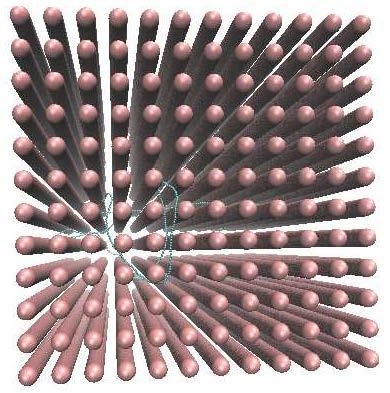Structural Behavior of a Semiflexible Polymer Chain in an Array of Nanoposts
Abstract
1. Introduction
2. Method and Model
3. Results and Discussion
3.1. Occupation Number
3.2. Chain Extension and Radius of Gyration
3.3. Structure Factor
3.4. Orientation Correlations
4. Conclusions
Acknowledgments
Author Contributions
Conflicts of Interest
References
- Reisner, W.; Pedersen, J.N.; Austin, R.H. DNA confinement in nanochannels: physics and biological applications. Rep. Prog. Phys. 2012, 75, 106601. [Google Scholar] [CrossRef] [PubMed]
- Dorfman, K.D.; King, S.B.; Olson, D.W.; Thomas, J.D.P.; Tree, D.R. Beyond Gel Electrophoresis: Microfluidic Separations, Fluorescence Burst Analysis, and DNA Stretching. Chem. Rev. 2013, 113, 2584–2667. [Google Scholar] [CrossRef] [PubMed]
- Cheng, J.Z.Y.; Sullivan, D.E. Free Energy of a Wormlike Polymer Chain Confined in a Slit: Crossover between Two Scaling Regime. Macromolecules 2006, 39, 7769–7773. [Google Scholar] [CrossRef]
- Jo, K.; Dhingra, D.M.; Odijk, T.; de Pablo, J.J.; Graham, M.D.; Runnheim, R.; Forrest, D.; Schwartz, D.C. A single-molecule barcoding system using nanoslits for DNA analysis. Proc. Natl. Acad. Sci. USA 2007, 104, 2673–2678. [Google Scholar] [CrossRef] [PubMed]
- Balducci, A.; Hsieh, C.-C.; Doyle, P.S. Relaxation of Stretched DNA in Slitlike Confinement. Phys. Rev. Lett. 2007, 99, 238102. [Google Scholar] [CrossRef] [PubMed]
- Hsieh, C.-C.; Doyle, P.S. Studying confined polymers using single-molecule DNA experiments. Korea-Aust. Rheol. J. 2008, 20, 127–142. [Google Scholar]
- Tang, J.; Levy, S.L.; Trahan, D.W.; Jones, J.J.; Craighead, H.G.; Doyle, P.S. Revisiting the Conformation and Dynamics of DNA in Slitlike Confinement. Macromolecules 2010, 43, 7368–7377. [Google Scholar] [CrossRef]
- Dai, L.; Jones, J.J.; Van der Maarel, J.R.C.; Doyle, P.S. A systematic study of DNA conformation in slitlike confinement. Soft Matter 2012, 8, 2972–2982. [Google Scholar] [CrossRef]
- Tree, D.R.; Reinhart, W.F.; Dorfman, K.D. The Odijk regime in slits. Macromolecules 2014, 47, 3672–3684. [Google Scholar] [CrossRef]
- Odijk, T. On the Statistics and Dynamics of Confined or Entangled Polymers. Macromolecules 1983, 16, 1340–1344. [Google Scholar] [CrossRef]
- Tegenfeldt, J.O.; Prinz, C.; Cao, H.; Chou, S.; Reisner, W.W.; Riehn, R.; Wang, Y.M.; Cox, E.C.; Sturm, J.C.; Silberzan, P.; et al. The Dynamics of Genomic-Length DNA Molecules in 100-nm Channels. Proc. Natl. Acad. Sci. USA 2004, 101, 10979–10983. [Google Scholar] [CrossRef] [PubMed]
- Reccius, C.H.; Mannion, J.T.; Cross, J.D.; Craighead, H.G. Compression and Free Expansion of Single DNA Molecules in Nanochannels. Phys. Rev. Lett. 2005, 95, 268101. [Google Scholar] [CrossRef] [PubMed]
- Reisner, W.; Morton, K.J.; Riehn, R.; Wang, Y.M.; Yu, Z.; Rosen, M.; Sturm, J.C.; Chou, S.Y.; Frey, E.; Austin, R.H. Statistics and Dynamics of Single DNA Molecules Confined in Nanochannels. Phys. Rev. Lett. 2005, 94, 196101. [Google Scholar] [CrossRef] [PubMed]
- Köster, S.; Kierfeld, J.; Pfohl, T. Characterization of single semiflexible filaments under geometric ccnstraints. Eur. Phys. J. E 2008, 25, 439–449. [Google Scholar] [CrossRef] [PubMed]
- Kalb, J.; Chakraborty, B. Single polymer confinement in a tube: Correlation between structure and dynamics. J. Chem. Phys. 2009, 130, 025103. [Google Scholar] [CrossRef] [PubMed]
- Cifra, P.; Benková, Z.; Bleha, T. Chain Extension of DNA Confined in Channels. J. Phys. Chem. B 2009, 113, 1843–1851. [Google Scholar] [CrossRef] [PubMed]
- Cifra, P.; Benková, Z.; Bleha, T. Persistence length of DNA molecules confined in nanochannels. Phys. Chem. Chem. Phys. 2010, 12, 8934–8942. [Google Scholar] [CrossRef] [PubMed]
- Burkhardt, T.W.; Yang, Y.; Gompper, G. Fluctuations of a long, semiflexible polymer in a narrow channel. Phys. Rev. E 2010, 82, 041801. [Google Scholar] [CrossRef] [PubMed]
- Wang, Y.; Tree, D.R.; Dorfman, K.D. Simulation of DNA Extension in Nanochannels. Macromolecules 2011, 44, 6594–6604. [Google Scholar] [CrossRef] [PubMed]
- Dai, L.; Ng, S.Y.; Doyle, P.S.; Van der Maarel, J.R.C. Conformation Model of Back-Folding and Looping of a Single DNA Molecule Confined Inside a Nanochannel. ACS Macro Lett. 2012, 1, 1046–1050. [Google Scholar] [CrossRef]
- Cheng, J.Z.Y. Free Energy and Extension of a Wormlike Chain in Tube Confinement. Macromolecules 2013, 46, 9837–9844. [Google Scholar] [CrossRef]
- Dai, L.; van der Maarel, J.; Doyle, P.S. Extended de Gennes Regime of DNA Confined in a Nanochannel. Macromolecules 2014, 47, 2445–2450. [Google Scholar] [CrossRef]
- Muralidhar, A.; Tree, D.R.; Dorfman, K.D. Backfolding of Wormlike Chains Confined in Nanochannels. Macromolecules 2014, 47, 8446–8458. [Google Scholar] [CrossRef]
- Muralidhar, A.; Tree, D.R.; Wang, Y.; Dorfman, K.D. Interplay between chain stiffness and excluded volume of semiflexible polymers confined in nanochannels. J. Chem. Phys. 2014, 140, 084905. [Google Scholar] [CrossRef] [PubMed]
- Werner, E.; Mehlig, B. Scaling regimes of a semiflexible polymer in a rectangular channel. Phys. Rev. E 2015, 91, 050601(R). [Google Scholar] [CrossRef] [PubMed]
- Gupta, D.; Miller, J.J.; Muralidhar, A.; Mahshid, S.; Reisner, W.; Dorfman, K.D. Experimental Evidence of Weak Excluded Volume Effects for Nanochannel Confined DNA. ACS Macro Lett. 2015, 4, 759–763. [Google Scholar] [CrossRef] [PubMed]
- Reinhart, W.F.; Reifenberger, J.G.; Gupta, D.; Muralidhar, A.; Sheats, J.; Cao, H.; Dorfman, K.D. Distribution of distances between DNA barcode labels in nanochannels close to the persistence length. J. Chem. Phys. 2015, 142, 064902. [Google Scholar] [CrossRef] [PubMed]
- Huang, A.; Hsu, H.-P.; Bhattacharya, A.; Dorfman, K.D. Semiflexible macromolecules in quasi-one-dimensional confinement: Discrete versus continuous bond angles. J. Chem. Phys. 2015, 143, 243102. [Google Scholar] [CrossRef] [PubMed]
- Muralidhar, A.; Dorfman, K.D. Backfolding of DNA Confined in Nanotubes: Flory Theory versus the Two-State Cooperativity Model. Macromolecules 2016, 49, 1120–1126. [Google Scholar] [CrossRef]
- Caccuito, A.; Luijten, E. Self-Avoiding Flexible Polymers under Spherical Confinement. Nano Lett. 2006, 6, 901–905. [Google Scholar] [CrossRef] [PubMed]
- Liu, Y.; Chakraborty, B. Shapes of semiflexible polymers in confined spaces. Phys. Biol. 2008, 5, 026004. [Google Scholar] [CrossRef] [PubMed]
- Morrison, G.; Thirumalai, D. Semiflexible chains in confined spaces. Phys. Rev. E 2009, 79, 011924. [Google Scholar] [CrossRef] [PubMed]
- Gao, J.; Tang, P.; Yang, Y.; Cheng, J.Z.Y. Free energy of a long semiflexible polymer confined in a spherical cavity. Soft Matter 2014, 10, 4674–4685. [Google Scholar] [CrossRef] [PubMed]
- Sakaue, T.; Raphaël, E. Polymer Chains in Confined Spaces and Flow-Injection Problems: Some Remarks. Macromolecules 2006, 39, 2621–2628. [Google Scholar] [CrossRef]
- Randel, R.; Loebl, H.C.; Matthai, C.C. Molecular dynamics simulations of polymer translocations. Macromol. Theory Simul. 2004, 13, 387–391. [Google Scholar] [CrossRef]
- Sousa, A.F.; Pais, A.; Linse, P. Polymer distribution in connected spherical domains. J. Chem. Phys. 2005, 122, 214902. [Google Scholar] [CrossRef] [PubMed]
- Matysiak, S.; Montesi, A.; Pasquali, M.; Kolomeisky, A.B.; Clementi, C. Dynamics of polymer translocation through nanopores: Theory meets experiment. Phys. Rev. Lett. 2006, 96, 118103. [Google Scholar] [CrossRef] [PubMed]
- Cifra, P. Asymmetric bridging of interconnected pores by encased semiflexible macromolecules. J. Chem. Phys. 2006, 124, 024706. [Google Scholar] [CrossRef] [PubMed]
- Gauthier, M.G.; Slater, G.W. A Monte Carlo algorithm to study polymer translocation through nanopores. I. Theory and numerical approach. J. Chem. Phys. 2008, 128, 065103. [Google Scholar] [CrossRef] [PubMed]
- Magil, M.; Falconer, C.; Waller, E.; de Haan, H.W. Translocation Time through a Nanopore with an Internal Cavity Is Minimal for Polymers of Intermediate Length. Phys. Rev. Lett. 2016, 117, 247802. [Google Scholar] [CrossRef] [PubMed]
- Volkmuth, W.D.; Austin, R.H. DNA electrophoresis in microlithographic arrays. Nature 1992, 358, 600–602. [Google Scholar] [CrossRef] [PubMed]
- Volkmuth, W.D.; Duke, T.; Wu, M.C.; Austin, R.H.; Szabo, A. DNA electrodiffusionin a 2D array of posts. Phys. Rev. Lett. 1994, 72, 2117–2120. [Google Scholar] [CrossRef] [PubMed]
- Duke, T.A.J.; Austin, R.H.; Cox, E.C.; Chan, S.S. Pulsed-field electrophoresis in microlithographic arrays. Electrophoresis 1996, 17, 1075–1079. [Google Scholar] [CrossRef] [PubMed]
- Bakajin, O.B.; Duke, T.A.J.; Chou, C.F.; Chan, S.S.; Austin, R.H.; Cox, E.C. Electrohydrodynamic stretching of DNA in confined environments. Phys. Rev. Lett. 1998, 80, 2737–2740. [Google Scholar] [CrossRef]
- Bakajin, O.; Duke, T.A.J.; Tegenfeldt, J.; Chou, C.F.; Chan, S.S.; Austin, R.H.; Cox, E.C. Separation of 100-kilobase DNA molecules in 10 seconds. Anal. Chem. 2001, 73, 6053–6056. [Google Scholar] [CrossRef] [PubMed]
- Kaji, N.; Tezuka, Y.; Takamura, Y.; Ueda, M.; Nishimoto, T.; Nakanishi, H.; Horiike, Y.; Baba, Y. Separation of long DNA molecules by quartz nanopillar chips under a direct current electric field. Anal. Chem. 2004, 76, 15–22. [Google Scholar] [CrossRef] [PubMed]
- Kaji, N.; Okamoto, Y.; Tokeshi, M.; Baba, Y. Nanopillar, nanoball, and nanofibers for highly efficient analysis of biomolecules. Chem. Soc. Rev. 2010, 39, 948–956. [Google Scholar] [CrossRef] [PubMed]
- Doyle, P.S.; Bibette, J.; Bancaud, A.; Viovy, J.L. Self-assembled magnetic matrices for DNA separation chips. Science 2002, 295, 2237. [Google Scholar] [CrossRef] [PubMed]
- Nixon, G.I.; Slater, G.W. DNA electrophoretic collisions with single obstacles. Phys. Rev. E 1994, 50, 5033–5038. [Google Scholar] [CrossRef]
- Sevick, E.M.; Williams, D.R.M. Motio of a polyelectrolyte chain hooked around a post. Phys. Rev. E 1994, 50, R3357–R3360. [Google Scholar] [CrossRef]
- Andre, P.; Long, D.; Ajdari, A. Polyelectrolyte/post collisions during electrophoresis: Influence of hydrodynamic interactions. Eur. Phy J. B 1998, 4, 307–312. [Google Scholar] [CrossRef]
- Saville, P.M.; Sevick, E.M. Collision of a field-driven polymer with a finite-sized obstacle: A Brownian dynamics simulation. Macromolecules 1999, 32, 892–899. [Google Scholar] [CrossRef]
- Randall, G.C.; Doyle, P.S. Electrophoretic collision of a DNA molecule with an insulating post. Phys. Rev. Lett. 2004, 93, 058102. [Google Scholar] [CrossRef] [PubMed]
- Randall, G.C.; Doyle, P.S. Collision of a DNA polymer with a small obstacle. Macromolecules 2006, 39, 7734–7745. [Google Scholar] [CrossRef]
- Patel, P.D.; Shaqfeh, E.S.G. A computational study of DNA separations in sparse disordered and periodic arrays of posts. J. Chem. Phys. 2003, 118, 2941–2951. [Google Scholar] [CrossRef]
- Randall, G.C.; Doyle, P.S. DNA deformation in electric fields: DNA driven past a cylindrical obstruction. Macromolecules 2005, 38, 2410–2418. [Google Scholar] [CrossRef]
- Joo, H.; Kim, J.S. Confinement and partitioning of a single polymer chain in a dense array of nanoposts. Soft Matter 2015, 11, 8262–8272. [Google Scholar] [CrossRef] [PubMed]
- Joon, H.; Kim, J.S. Confinement-driven organization of a histone complexed DNA molecule in a dense array of nanoposts. Nanoscale 2017, 9, 6391–6398. [Google Scholar]
- Persson, F.; Utko, P.; Reisner, W.; Larsen, N.B.; Kristensen, A. Confinement Spectroscopy: Probing Single DNA Molecules with Tapered Nanochannels. Nano Lett. 2009, 9, 1382–1385. [Google Scholar] [CrossRef] [PubMed]
- Benková, Z.; Cifra, P. Simulation of Semiflexible Cyclic and Linear Chains Moderately and Strongly Confined in Nanochannels. Macromolecules 2012, 45, 2597–2608. [Google Scholar] [CrossRef]
- Alizadehheidaru, M.; Werner, E.; Noble, C.; Reiter-Schad, M.; Nyberg, L.K.; Fritzsche, J.; Mehlig, B.; Tegenfeldt, J.O.; Ambjörnsson, T.; Persson, F.; et al. Nanoconfined Circular and Linear DNA: Equilibrium Conformations and Unfolding Kinetics. Macromolecules 2015, 48, 871–878. [Google Scholar] [CrossRef]
- Benková, Z.; Námer, P.; Cifra, P. Comparison of a stripe and slab confinement for soft ring and linear macromolecules in nanochannel. Soft Matter 2016, 12, 8425–8439. [Google Scholar] [CrossRef] [PubMed]
- Huang, A.; Bhattacharya, A.; Binder, K. Conformations, transverse fluctuations, and crossover dynamics of a semi-flexible chain in two dimensions. J. Chem. Phys. 2014, 140, 214902. [Google Scholar] [CrossRef] [PubMed]
- Shirvanyants, D.; Panyukov, S.; Liao, Q.; Rubinstein, M. Long-Range Correlations in a Polymer Chain Due to Its Connectivity. Macromolecules 2008, 41, 1475–1485. [Google Scholar] [CrossRef]
- Cifra, P. Channel confinement of flexible and semiflexible macromolecules. J. Chem. Phys. 2009, 131, 224903. [Google Scholar] [CrossRef] [PubMed]
- Todorov, I.T.; Smith, W.; Trachenko, K.; Dove, M.T. DL_POLY_3: New dimensions in molecular dynamics simulations via massive parallelism. J. Mater. Chem. 2006, 16, 1911–1918. [Google Scholar] [CrossRef]
- Cifra, P.; Teraoka, I. Partitioning of polymer chains in solution with a square channel: Lattice Monte Carlo simulations. Polymer 2002, 43, 2409–2415. [Google Scholar] [CrossRef]
- Wang, Y.; Peters, G.H.; Hansen, F.Y.; Hassager, O. Equilibrium partitioning of macromolecules in confining geometries: Improved universality with a new molecular size parameter. J. Chem. Phys. 2008, 128, 124904. [Google Scholar] [CrossRef] [PubMed]
- Brochard, F.; de Gennes, P.-G. Dynamics of confined polymer chains. J. Chem. Phys. 1977, 67, 52–56. [Google Scholar] [CrossRef]
- Daoud, M.; de Gennes, P.-G. Statistics of macromolecular solutions trapped in small pores. J. Phys. France 1977, 38, 85–93. [Google Scholar] [CrossRef]
- Taloni, A.; Yeh, J.W.; Chou, C.F. Scaling Theory of Stretched Polymers in Nanoslits. Macromolecules 2013, 46, 7989–8002. [Google Scholar] [CrossRef]
- Brochard-Wyart, F.; Tanaka, T.; Borghi, N.; de Gennes, P.-G. Semiflexible Polymers Confined in Soft Tubes. Langmuir 2005, 21, 4144–4148. [Google Scholar] [CrossRef] [PubMed]
- Odijk, T. Scaling theory of DNA confined in nanochannels and nanoslits. Phys. Rev. E 2008, 77, 060901(R). [Google Scholar] [CrossRef] [PubMed]
- Benková, Z.; Námer, P.; Cifra, P. Stripe to slab confinement for the linearization of macromolecules in nanochannels. Soft Matter 2015, 11, 2279–2289. [Google Scholar] [CrossRef] [PubMed]
- Hsu, H.-P.; Paul, W.; Binder, K. Scattering function of semiflexible polymer chains under good solvent conditions. J. Chem. Phys. 2012, 137, 174902. [Google Scholar] [CrossRef] [PubMed]
- Tree, D.R.; Wang, Y.; Dorfman, K.D. Extension of DNA in a Nanochannel as a Rod-to-Coil Transition. Phys. Rev. Lett. 2013, 110, 208103. [Google Scholar] [CrossRef] [PubMed]
- Witz, G.; Rechendorff, K.; Adamcik, J.; Dietler, G. Conformation of Circular DNA in Two Dimensions. Phys. Rev. Lett. 2008, 101, 148103. [Google Scholar] [CrossRef] [PubMed]
- Benková, Z.; Cifra, P. Stiffening Transition in Semiflexible Cyclic Macromolecules. Macromol. Theory Simul. 2011, 20, 65–74. [Google Scholar] [CrossRef]
- Hsu, H.-P.; Paul, W.; Binder, K. Estimation of persistence lengths of semiflexible polymers: Insight from simulations. Polym. Sci. Ser. C 2013, 55, 39–59. [Google Scholar] [CrossRef]
- Wagner, F.; Lattanzi, G.; Frey, E. Conformations of confined biopolymers. Phys. Rev. E 2007, 75, 050902(R). [Google Scholar] [CrossRef] [PubMed]
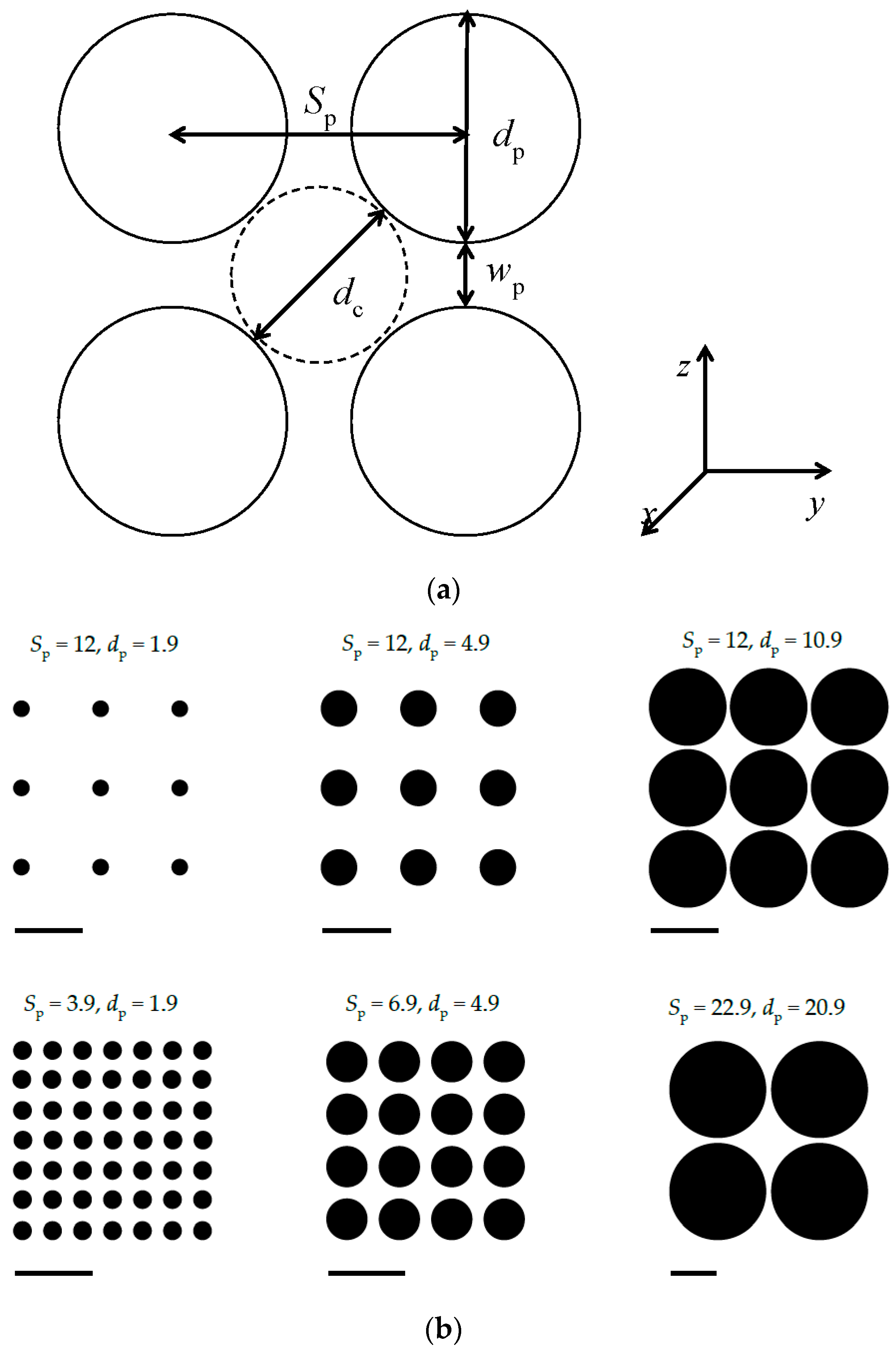
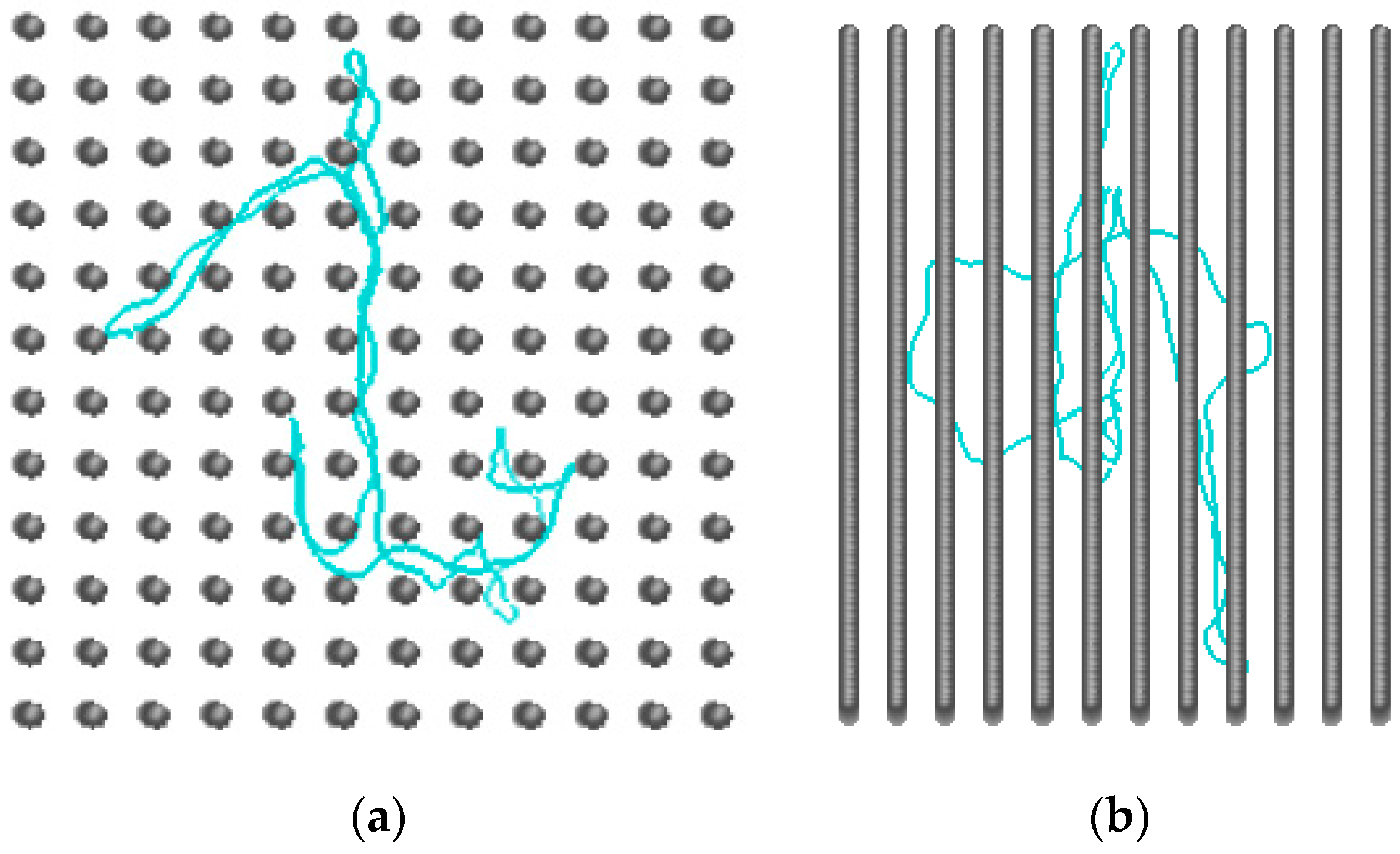
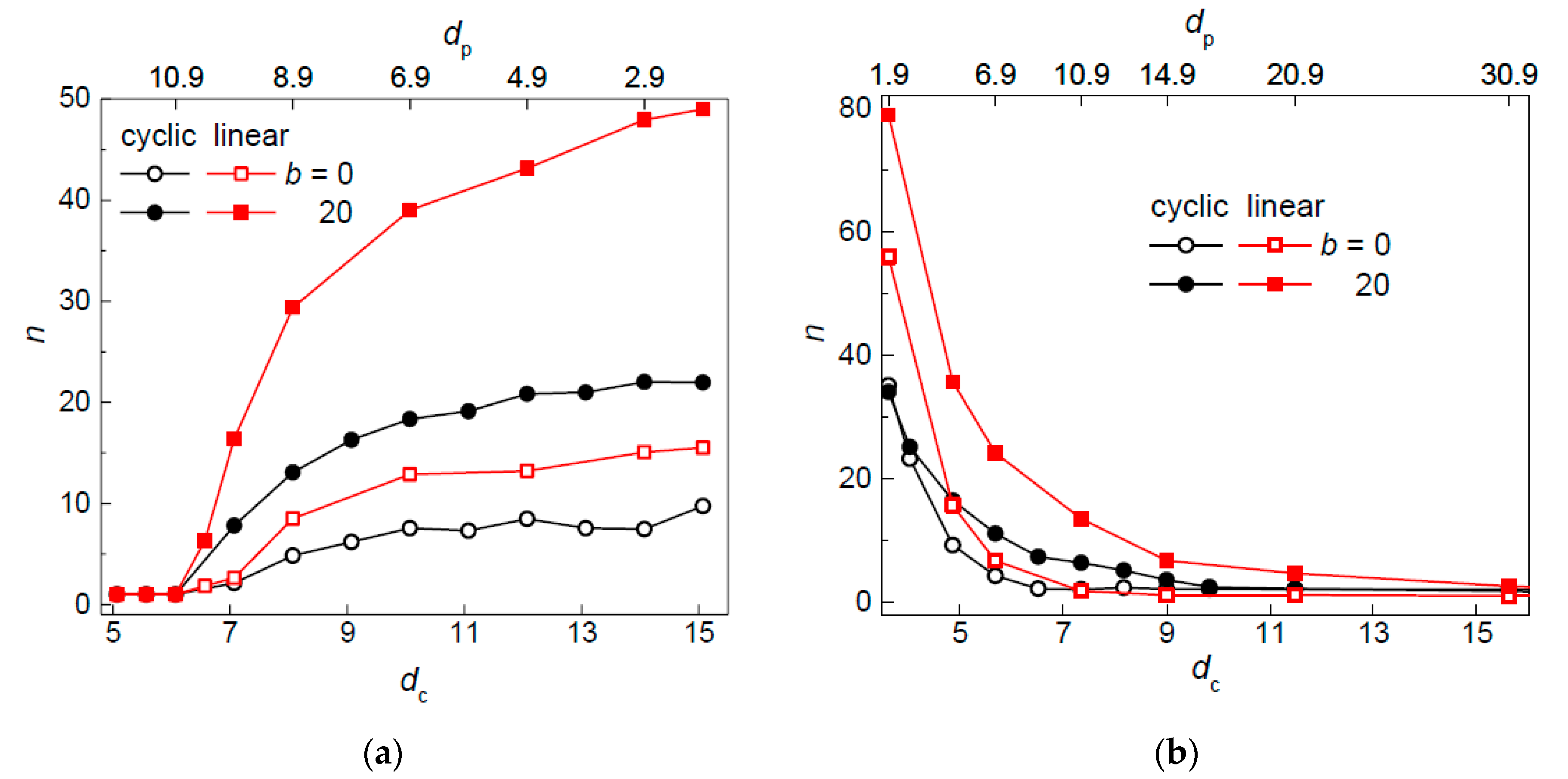
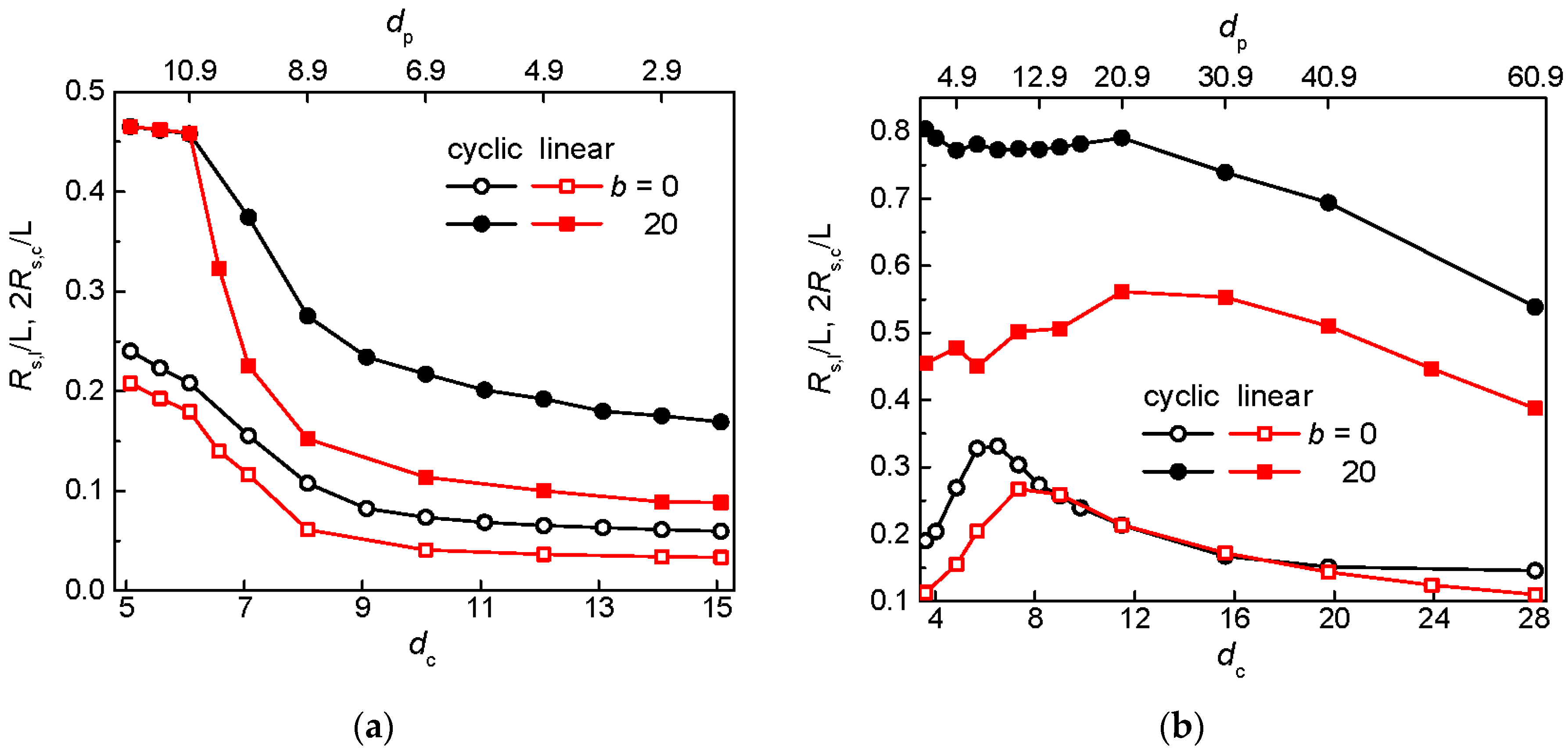
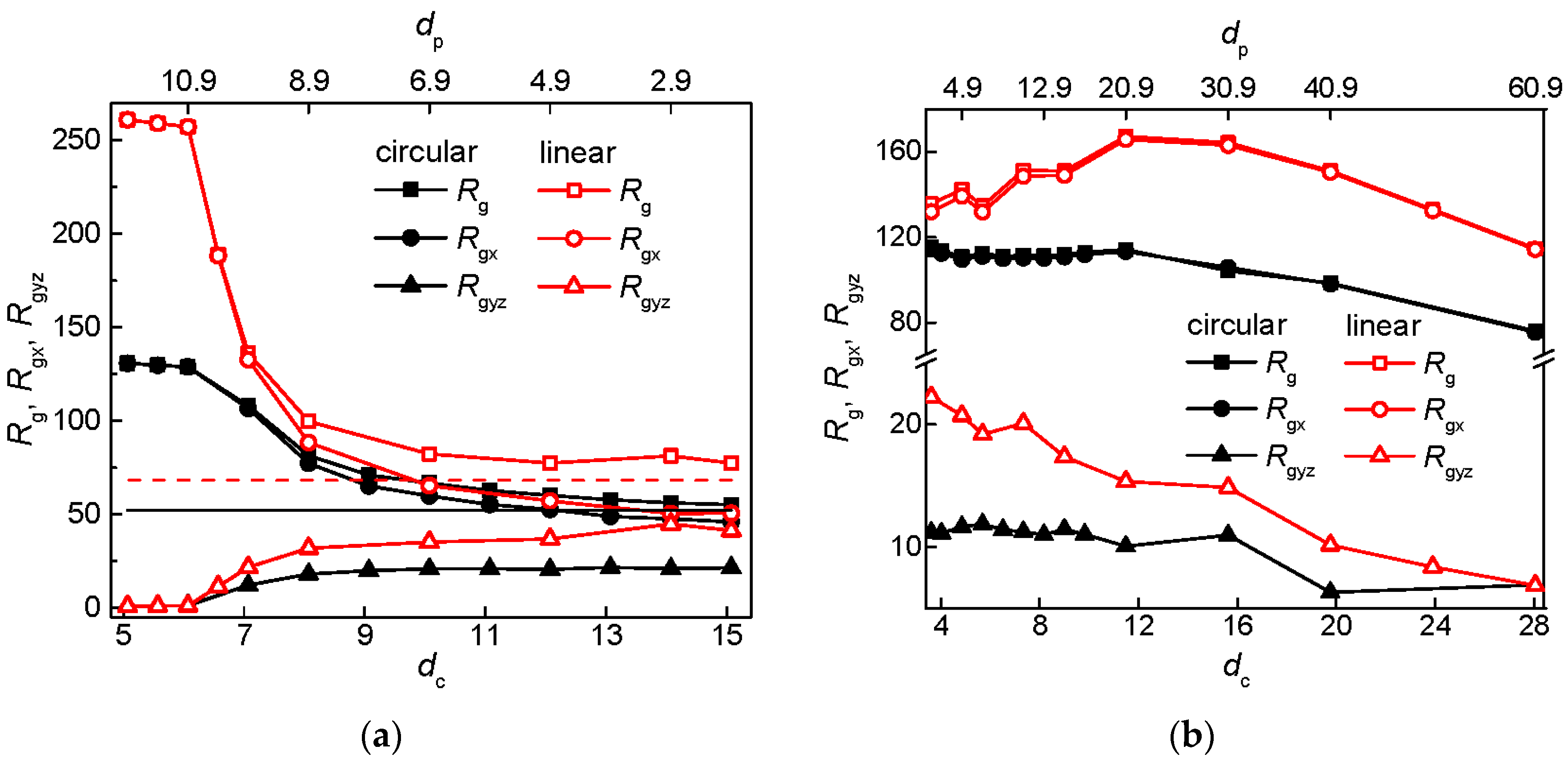
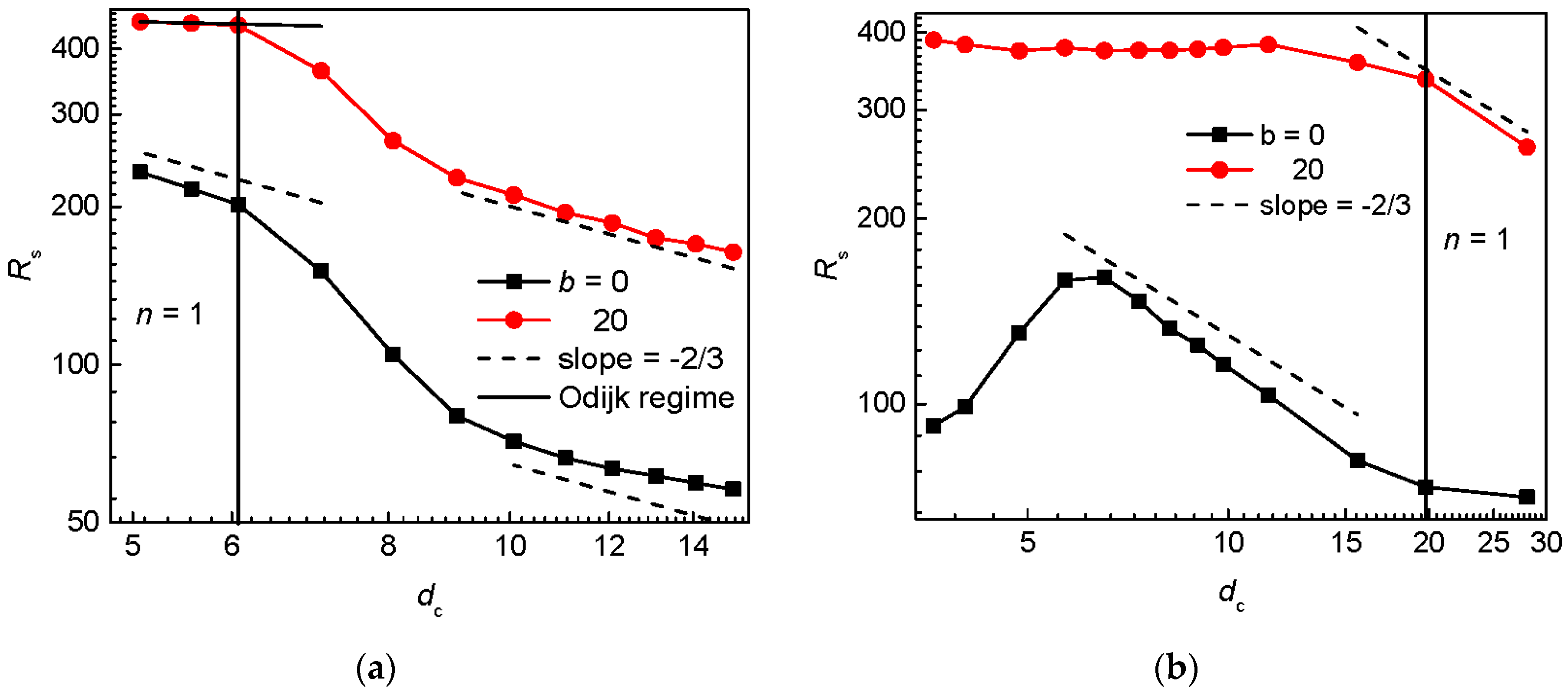
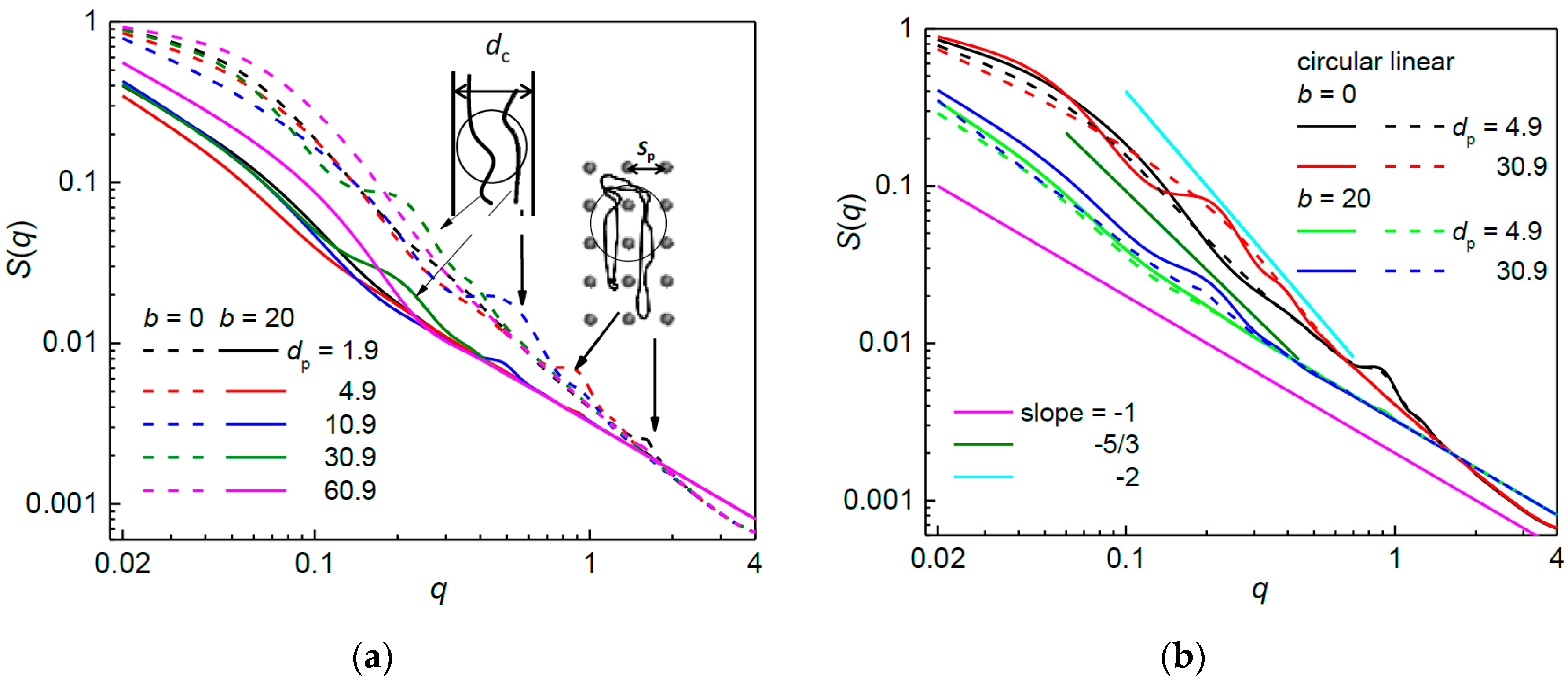
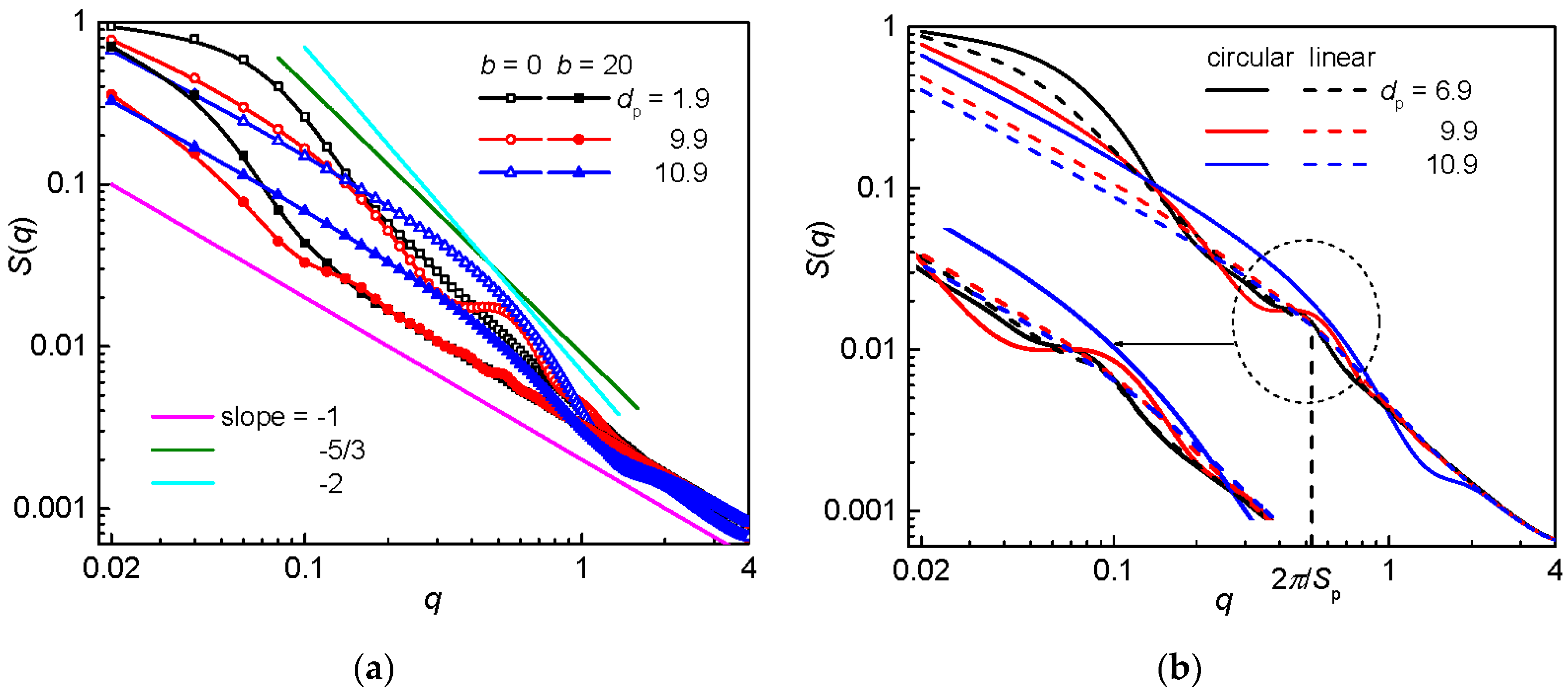
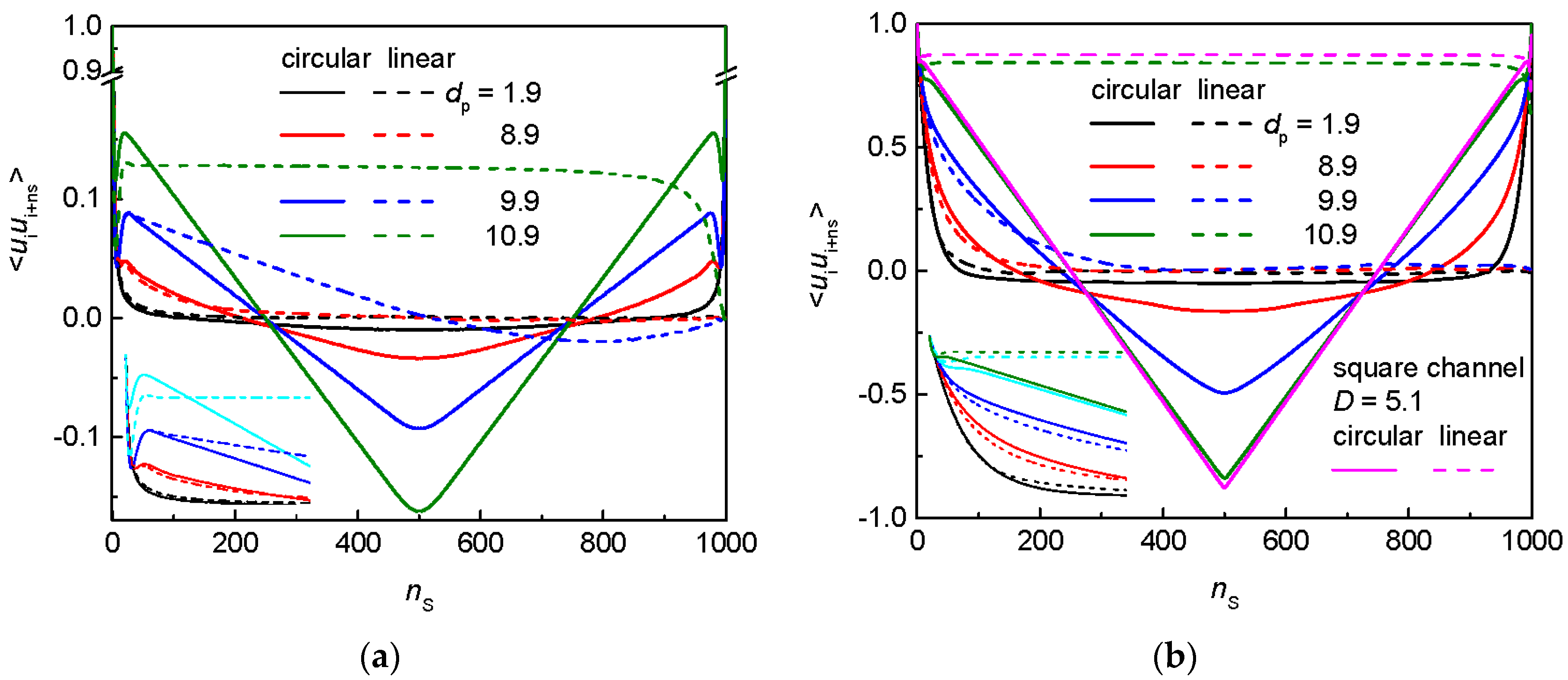
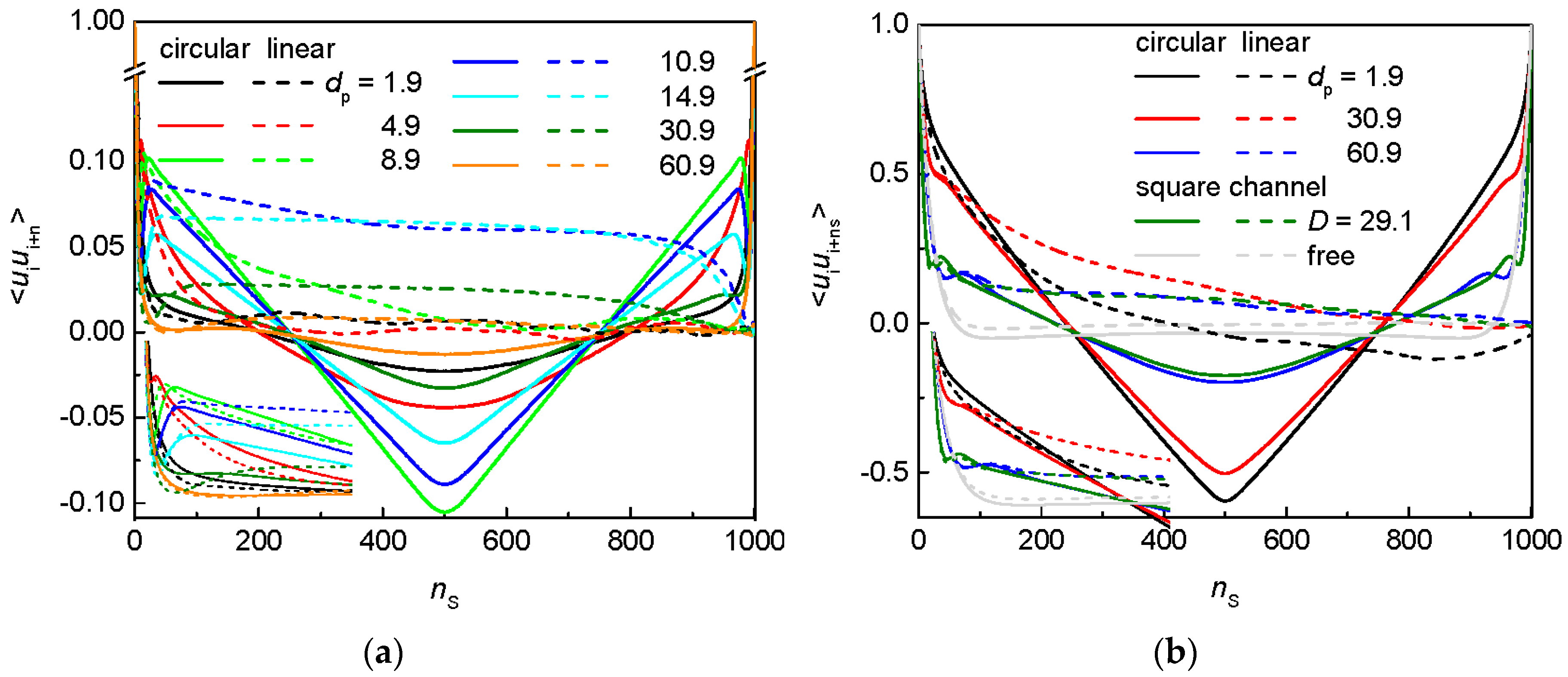
| Sp = 12 | wp = 2 | ||||||||
|---|---|---|---|---|---|---|---|---|---|
| dp | wp | dc | F | dc/wp | dp | Sp | dc | F | dc/wp |
| 1.9 | 10.1 | 15.071 | 0.020 | 1.492 | 1.9 | 3.9 | 3.615 | 0.186 | 1.808 |
| 2.9 | 9.1 | 14.071 | 0.046 | 1.546 | 2.9 | 4.9 | 4.030 | 0.275 | 2.015 |
| 3.9 | 8.1 | 13.071 | 0.083 | 1.614 | 4.9 | 6.9 | 4.858 | 0.396 | 2.429 |
| 4.9 | 7.1 | 12.071 | 0.131 | 1.700 | 6.9 | 8.9 | 5.687 | 0.472 | 2.843 |
| 5.9 | 6.1 | 11.071 | 0.190 | 1.815 | 8.9 | 10.9 | 6.515 | 0.524 | 3.257 |
| 6.9 | 5.1 | 10.071 | 0.260 | 1.975 | 10.9 | 12.9 | 7.343 | 0.561 | 3.672 |
| 7.9 | 4.1 | 9.071 | 0.340 | 2.212 | 12.9 | 14.9 | 8.172 | 0.589 | 4.086 |
| 8.9 | 3.1 | 8.071 | 0.432 | 2.603 | 14.9 | 16.9 | 9.000 | 0.611 | 4.500 |
| 9.9 | 2.1 | 7.071 | 0.535 | 3.367 | 16.9 | 18.9 | 9.829 | 0.628 | 4.914 |
| 10.9 | 1.1 | 6.071 | 0.648 | 5.519 | 20.9 | 22.9 | 11.485 | 0.654 | 5.743 |
| 11.4 | 0.6 | 5.571 | 0.709 | 9.284 | 30.9 | 32.9 | 15.628 | 0.693 | 7.814 |
| 11.9 | 0.1 | 5.071 | 0.772 | 50.706 | 40.9 | 42.9 | 19.770 | 0.714 | 9.885 |
| 50.9 | 52.9 | 23.912 | 0.727 | 11.956 | |||||
| 60.9 | 62.9 | 28.054 | 0.736 | 14.027 | |||||
| Circular | ||||
| Sp = 12 | wp = 2 | |||
| b = 0 | b = 20 | b = 0 | b = 20 | |
| dc/wp | 5.5 | 5.5 | 14.0 | 14.0 |
| Linear | ||||
| Sp = 12 | wp = 2 | |||
| b = 0 | b = 20 | b = 0 | b = 20 | |
| dc/wp | 5.5 | 5.5 | 9.9 | 14.0 |
© 2017 by the authors. Licensee MDPI, Basel, Switzerland. This article is an open access article distributed under the terms and conditions of the Creative Commons Attribution (CC BY) license (http://creativecommons.org/licenses/by/4.0/).
Share and Cite
Benková, Z.; Rišpanová, L.; Cifra, P. Structural Behavior of a Semiflexible Polymer Chain in an Array of Nanoposts. Polymers 2017, 9, 313. https://doi.org/10.3390/polym9080313
Benková Z, Rišpanová L, Cifra P. Structural Behavior of a Semiflexible Polymer Chain in an Array of Nanoposts. Polymers. 2017; 9(8):313. https://doi.org/10.3390/polym9080313
Chicago/Turabian StyleBenková, Zuzana, Lucia Rišpanová, and Peter Cifra. 2017. "Structural Behavior of a Semiflexible Polymer Chain in an Array of Nanoposts" Polymers 9, no. 8: 313. https://doi.org/10.3390/polym9080313
APA StyleBenková, Z., Rišpanová, L., & Cifra, P. (2017). Structural Behavior of a Semiflexible Polymer Chain in an Array of Nanoposts. Polymers, 9(8), 313. https://doi.org/10.3390/polym9080313




